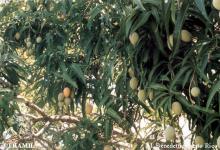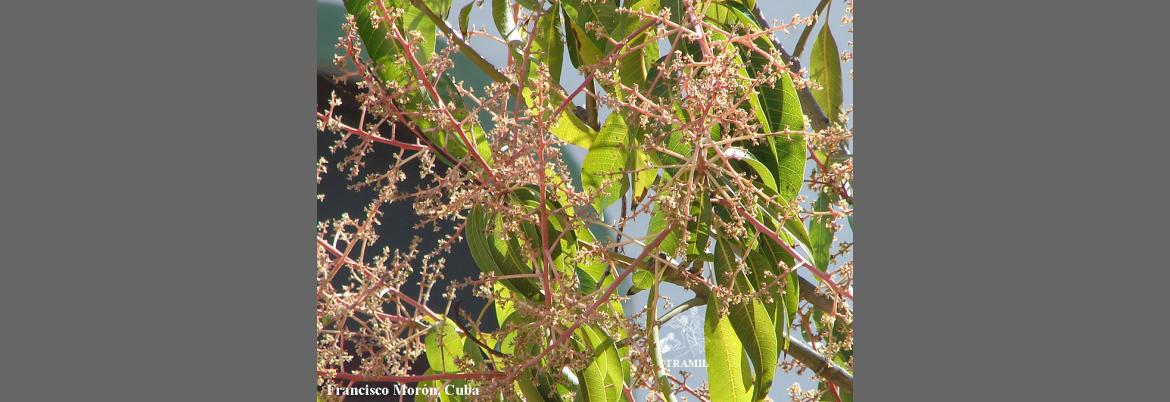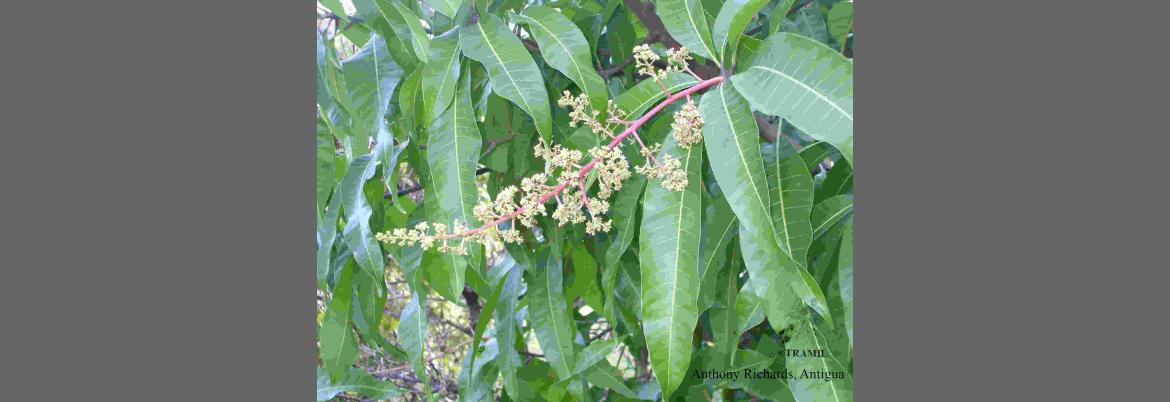1 GIRON L, 1988 Encuesta TRAMIL (Costa atlántica). Centro Mesoamericano de Tecnología CEMAT, Guatemala, Guatemala.
2 JEAN-PIERRE L, 1988 TRAMIL survey. St. Lucia national herbarium, Castries, St. Lucia
3 WENIGER B, ROUZIER M, 1986 Enquête TRAMIL. Service Oecuménique d'Entraide SOE, Port au Prince, Haïti.
4 CRAVEIRO AA, ANDRADE CH, MATOS FJ, ALENCAR JW, MACHADO MI, 1980 Volatile constituents of Mangifera indica Linn. Rev Latinoamer Quim 11:129.
5 TANAKA T, SUEYASU T, NONAKA G-I, NISHIOKA I, 1984 Tannins and related compounds. XXI. Isolation and characterization of galloyl and p-hydroxybenzoyl esters of benzophenone and xanthone c-glucosides from Mangifera indica L. Chem Pharm Bull 32(7):2676-2686.
6 PROCTOR JTA, CREASY LL, 1969 The anthocyanin of the mango fruit. Phytochemistry 8:2108.
7 SHAFT N, IKRAM M, 1982 Quantitative survey of rutin-containing plants. Part 1. Int J Crude Drug Res 20(4):183-186.
8 NIGAM IC, 1962 Studies in some Indian essential oils. Agra Univ J Res Sci 11:147-152.
9 LU ZY, MAO HD, HE MR, LU SY, 1982 Studies on the chemical constituents of mangguo (Mangifera indica) leaf. Chung Ts'ao Yao 13:3-6.
10 PHARM XS, PHARM GK, 1991 The extraction and determination of the flavonoid mangiferin in the bark and leaves of Mangifera indica. Tap Chi Duoc Hoc 5:8-19.
11 ANJANEYULU V, HARISCHANDRA PRASAD K, SAMBASIVA RAO G, 1982 Triterpenoids of the leaves of Mangifera indica. Indian J Pharm Sci 44:58-59.
12 GRIFFITHS LA, 1959 On the distribution of gentisic acid in green plants. J Exp Biol 10:437-442.
13 GHOSAL S, BISWAS K, CHATTOPADHYAY BK, 1978 Differences in the chemical constituents of Mangifera indica infected with Aspergillus niger and Fusarium moniliformae. Phytochemistry 17:689-694.
14 KHAN MA, KHAN MNI, 1989 Alkyl gallates of flowers of Mangifera indica. Fitoterapia 60(3):284.
15 KHAN MA, KHAN MNI, 1993 Studies in the chemical constituents of flowers of Mangifera indica. Part-II. Isolation and characterization of some alkylgallates from blossoms of Mangifera indica. Pak J Sci Ind 35(7/8):276-278.
16 BANDYOPADHYAY C, 1983 Contribution of gas chromatography to food flavor research. Pafai J 5(3):26-30.
17 SAEED AR, KARAMALLA KA, KHATTAB AH, 1976 Polyphenolic compounds in the pulp of Mangifera indica L. J Food Sci 41(4):959-960.
18 MAC LEOD AJ, DE TROCONIS NG, 1982 Volatile flavour components of mango fruit. Phytochemistry 21:2523-2526.
19 GAYDOU EM, BOUCHET P, 1984 Sterols, methyl sterols, triterpene alcohols and fatty acids of the kernel fat of different Malagasy mango (Mangifera indica) varieties. J Amer Oil Chem Soc 61(10):1589-1593.
20 ANJANEYULU V, RAVI K, HARISCHANDRA PRASAD K, CONNOLLY JD, 1989 Triterpenoids from Mangifera indica. Phytochemistry 28(5):1471-1477.
21 ANJANEYULU V, HARISCHANDRA K, RAVI PK, CONNOLLY JD, 1985 Triterpenoids from Mangifera indica. Phytochemistry 24(10):2359-2367.
22 ANJANEYULU V, HARISCHANDRA PRASAD K, SAMBASIVA RAO G, INDIAN J, 1982 Triterpenoids of the root-bark of Mangifera indica. Pharm Sci 44(4):85-87.
23 KHAN MA, NIZAMI SS, KHAN MNI, AZEEM SW, AHMED Z, 1994 New triterpenes from Mangifera indica. J Nat Prod 57(7):988-991.
24 DUKE JA, ATCHLEY AA, 1986 Handbook of proximate analysis tables of higher plants. Boca Raton, USA: CRC Press. p105.
25 GarcIa GM, Coto MT, GonzAlez CS, Pazos L, 1998 Velocidad del tránsito intestinal en ratón, del extracto acuoso de hoja fresca de Mangifera indica. Informe TRAMIL. Laboratorio de Ensayos Biológicos LEBi, Escuela de Medicina, Universidad de Costa Rica, San Pedro, Costa Rica.
26 CACERES A, GONZALEZ S, GIRON L, 1998 Demostración de la actividad antimicrobiana de plantas tramil en base a los usos populares en la cuenca del Caribe. Informe TRAMIL. Laboratorio de productos fitofarmacéuticos Farmaya y Facultad de Ciencias Químicas y Farmacia, Universidad de San Carlos, Guatemala, Guatemala.
27GarcIa GM, Coto MT, GonzAlez CS, Pazos L, 1999 Actividad bronquial del extracto acuoso de flores frescas de Mangifera indica. Informe TRAMIL. Laboratorio de Ensayos Biológicos LEBI, Escuela de Medicina, Universidad de Costa Rica, San Pedro, Costa Rica.
28 SOUZA BRITO ARM, HIRUMA-LIMA CA, LIMA ZP, 2003 Atividades biológicas obtidas dos extratos hidroalcoólicos das folhas e flores da Mangifera indica. Informe TRAMIL, Depto. Fisiologia, Inst. Biociências UNESP, Botucatu, SP y Depto. Fisiologia, Inst. Biologia, UNICAMP, Campinas, Sao Paulo, Brasil.
29 POUSSET J, 1989 Plantes médicinales africaines. Utilisation pratique. Paris, France: ACCT.
30 RAY BN, PAL AK, 1967 Estrogenic activity of tree leaves as animal feed. Indian J Physiol Allied Sci 20:6.
31 TRIPATHI RKR, TRIPATHI RN, 1982 Reduction in bean common mosaic virus (bcmv) infectivity vis-a-vis crude leaf extract of some higher plants. Experientia 38(3):349-349.
32 CACERES A, JAUREGUI E, HERRERA D, LOGEMANN H, 1991 Plants used in Guatemala for the treatment of dermatomucosal infections. 1: Screening of 38 plant extracts for anticandidal activity. J Ethnopharmacol 33(3):277-283.
33 GEORGE M, PANDALAI KM, 1949 Investigations on plant antibiotics. Part IV. Further search for antibiotic substances in Indian medicinal plants. Indian J Med Res 37:169-181.
34 PATEL VK, VENKATAKRISHNA-BHATT H, 1988 Folklore therapeutic indigenous plants in periodontal disorders in India (review, experimental and clinical approach). Int J Clin Pharmacol Ther Toxicol 26(4):176-184.
35 VIJAYALAKSHIMI K, MISHRA SD, PRASAD SK, 1979 Nematicidal properties of some indigenous plant materials against second stage juveniles of Meloidogyne incognita (koffoid and white) chitwood. Indian J Entomol 41(4):326-331.
36 JAIN SR, SHARMA SN, 1967 Hypoglycaemic drugs of Indian indigenous origin. Planta Med 15(4):439-442.
37 MALCOLM SA, SOFOWORA EA, 1969 Antimicrobial activity of selected Nigerian folk remedies and their constituent plants. Lloydia 32:512-517.
38 VAN DEN BERGHE DA, IEVEN M, MERTENS F, VLIETINCK AJ, LAMMENS E, 1978 Screening of higher plants for biological activities. II. Antiviral activity. J Nat Prod 41: 463-467.
39 KLOOS H, THIONGO FW, OUMA JH, BUTTERWORTH AE, 1987 Preliminary evaluation of some wild and cultivated plants for snail control in Machakos district, Kenya. J Trop Med Hyg 90(4):197-204.
40 ASWAL BS, BHAKUNI DS, GOEL AK, KAR K, MEHROTRA BN, MUKHERJEE KC, 1984 Screening of Indian plants for biological activity: Part X. Indian J Exp Biol 22(6):312-332.
41 HERRERA J, 1992 Determinación de parámetros farmacológicos usados en medicina tradicional popular en la cuenca del Caribe. Informe TRAMIL. Dep. de Farmacología, Facultad de Salud, Universidad del Valle, Cali, Colombia.
42 GarcIa GM, Coto MT, GonzAlez CS, Pazos L, 2000 Toxicidad aguda en ratones, del extracto acuoso de flores frescas de Mangifera indica. Informe TRAMIL. Laboratorio de Ensayos Biológicos LEBi, Escuela de Medicina, Universidad de Costa Rica, San Pedro, Costa Rica.
43 OLIVER-BEVER B, 1986 Medicinal plants in tropical West Africa. Cambridge, USA: Cambridge University Press.
44 GUPTA MP, ARIAS TD, CORREA M, LAMBA SS, 1979 Ethnopharmacognostic observations on Panamanian medicinal plants. Part I. Q J Crude Drug Res 17(3/4):115-130.
























